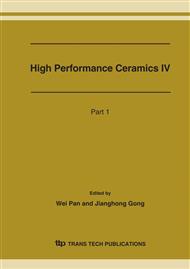p.739
p.743
p.746
p.750
p.754
p.758
p.760
p.763
p.765
The Optical and Electrical Properties of Antimony-Doped Tin Oxide Transparent Conducting Thin Films Prepared by Sol-Gel Dip-Coating Technique
Abstract:
Antimony-doped tin oxide (ATO) transparent conducting thin films were prepared by sol-gel dip-coating technique in the alcohol solution of metal salts of tin (II) chloride dehydrate and antimony tri-chloride. Usual glass slides (25×76×1mm3) were used as the substrates. As-prepared thin films were dried at temperature of 343K and annealed at temperatures of 673~823K. Their optical properties were analyzed by Hitachi U-3310 spectrophotometer. The good optical transmission of the ATO thin films has been obtained as high as 80%-90% in visible region by the optimization of deposition conditions, but decreased substantially in IR region. From the X-ray diffraction (XRD) measurements, it showed that ATO films had the similar structures with the pure tin oxide films, i.e. tetragonal rutile structure, despite of some rhombic SnO crystals. We analyzed the transmittance in the visible region depending on the vary Sb doped level, temperature, and dip-coating times. The sheet resistance of the investigated thin films was determined by four-probe method, showing that it was about 85-1009/□, which decreased with the increase of antimony doped concentration.
Info:
Periodical:
Pages:
754-757
Citation:
Online since:
April 2007
Authors:
Price:
Сopyright:
© 2007 Trans Tech Publications Ltd. All Rights Reserved
Share:
Citation:


